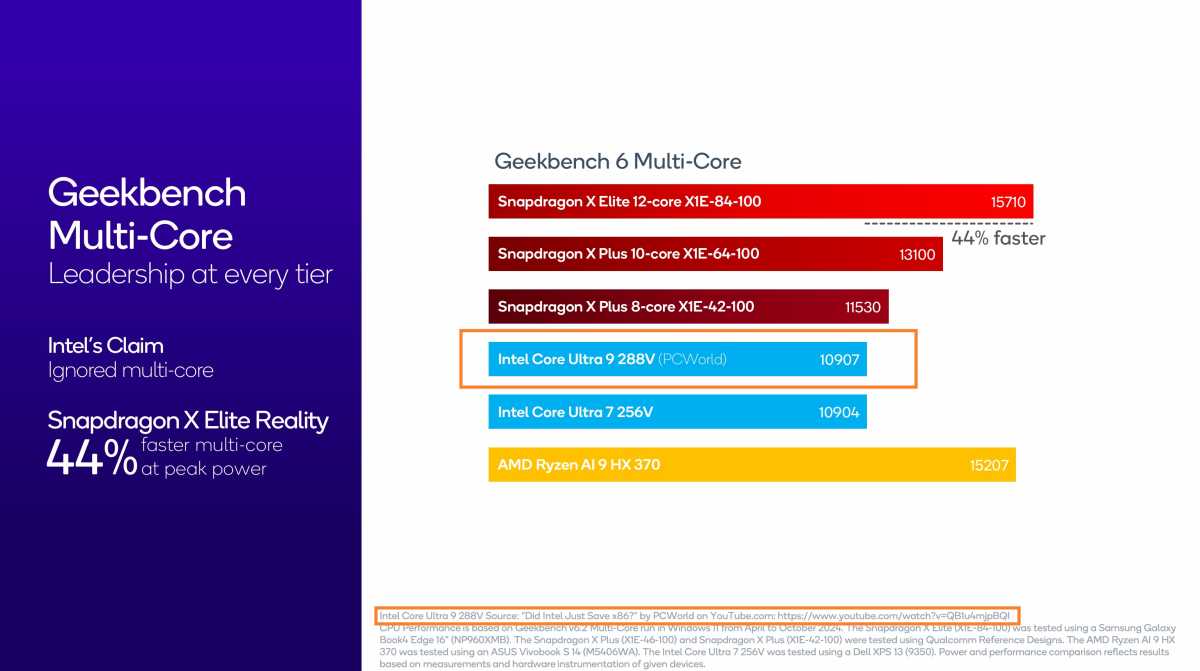
Qualcomm turns to PCWorld to resolve Snapdragon testing claims
 Image: Mark Hachman / IDG
Image: Mark Hachman / IDG
Qualcomm has attacked Intel for “misleading” claims the company has made in marketing its Lunar Lake processors, with the former citing PCWorld’s own Snapdragon and Core testing as evidence.
In a presentation to reporters, Qualcomm cited PCWorld’s video review, “Did Intel Just Save X86?”, as a source for its refutation, including benchmark scores that Qualcomm claimed could only be obtained using samples of Core Ultra Series 200 (Lunar Lake) laptops that were sent to reporters, not sold on the open market.
Qualcomm executives used the video by PCWorld’s Gordon Mah Ung as evidence, precisely because he was able to obtain two virtually identical laptops from Dell, with the same capacity, battery, and screen size. The two laptops differed only in their choice of processor, a relative rarity in the laptop world, but one that allowed him to directly compare one chip to the other.
Qualcomm director of engineering Sriram Dixit highlighted something our Lunar Lake print review showed, which he said Intel glossed over: That when a Lunar Lake laptop was tested only on battery, performance plunged.
Dixit briefed reporters slightly before Qualcomm announced its second-generation Snapdragon Oryon core for smartphones, a chip that Qualcomm claimed could outperform a Lunar Lake PC. Qualcomm isn’t saying whether the Oryon core will come to PCs, and a company representative declined to comment on the company’s roadmap.

Qualcomm
Qualcomm claimed shenanigans from the start. PCWorld’s Ung tested both the Core Ultra 258V as well as the Core Ultra 9 288V. The latter, Dixit claimed, was a chip that cannot be bought on the open market. In fact, Qualcomm’s Dixit said that he had to cite PCWorld rather than buy a notebook for independent confirmation. When a manufacturer launches but does not ship a chip, it has historically been referred to as a “paper launch,” a term Dixit did not specifically use.
“We are not able to find that in retail,” Dixit said of the Core Ultra 9 288V. “It’s not available in retail.”
Qualcomm also believes that Intel was disingenuous in the fact that it requires more power to reach its performance claims — about 113 percent more than Qualcomm’s battery-sipping Arm architecture. When run on wall power, Dixit said, both Qualcomm’s Snapdragon X Elite and the Lunar Lake chip were very close in performance. On battery power, performance on both chips dropped — but the Core Ultra’s fell far, far more.

Qualcomm
That’s the same result I found when I ran my benchmarks on battery and wall power for PCWorld. On certain tests — e.g. Procyon Office, which measures performance across a variety of Microsoft Office tasks — performance plunged by nearly half.
“So yes, you get, you know, better battery life than [wall power], but it comes at the expense of a huge drop in performance for Intel,” Dixit said.
If you’re confused, you can go right to the source: PCWorld’s Lunar Lake review, and our Lunar Lake video as well. Both back up Qualcomm’s claims, but also add more context. It’s not a clear-cut win for either side.
Author: Mark Hachman, Senior Editor, PCWorld

Mark has written for PCWorld for the last decade, with 30 years of experience covering technology. He has authored over 3,500 articles for PCWorld alone, covering PC microprocessors, peripherals, and Microsoft Windows, among other topics. Mark has written for publications including PC Magazine, Byte, eWEEK, Popular Science and Electronic Buyers’ News, where he shared a Jesse H. Neal Award for breaking news. He recently handed over a collection of several dozen Thunderbolt docks and USB-C hubs because his office simply has no more room.
Recent stories by Mark Hachman:
Arm will cancel Qualcomm’s license to make the Snapdragon X EliteQualcomm: Our new Snapdragon Oryon phone chip is faster than Intel’s Lunar LakeQualcomm’s new Snapdragon 8 Elite chip could tip a new PC CPU